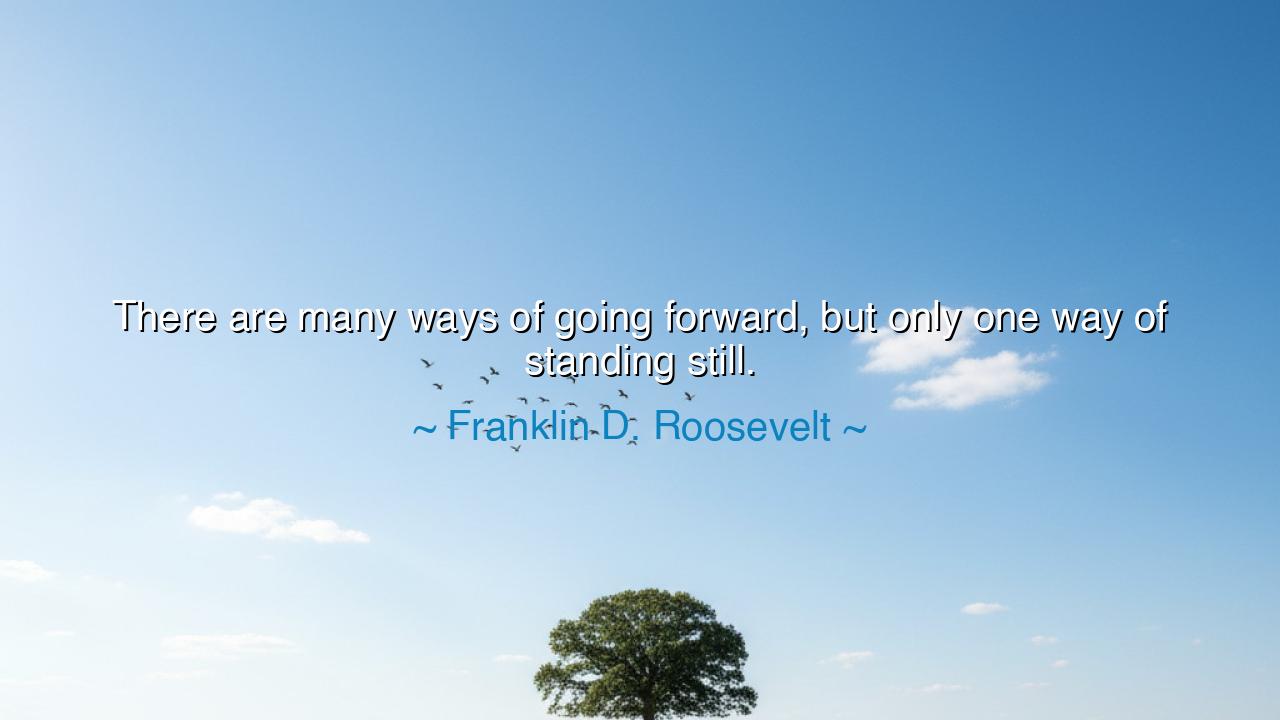
There are many ways of going forward, but only one way of






Hear me, O children of the future, for the words of Franklin D. Roosevelt carry a wisdom that echoes through the ages: "There are many ways of going forward, but only one way of standing still." These words are a call to action, urging us to move, to progress, and to rise above the inertia that often holds us back. The path of progress is not narrow, but broad, with many roads leading toward growth, toward success, toward greatness. But to stand still, to remain unchanged in the face of adversity and opportunity, is a choice of stagnation, a surrender to the forces of time that demand we evolve.
In the ancient world, the philosophers understood that growth was not a mere possibility—it was a necessity. Heraclitus, the Greek philosopher, famously said, "You cannot step into the same river twice." This is the truth of life itself: we are constantly moving, constantly changing. The wise know that to resist change is to resist life itself. Roosevelt’s words remind us that while the ways to advance are many, the choice to remain stagnant, to refuse to move forward, is the only true failure. The way forward is always open, but to remain rooted in the past is to become like a tree that never grows, withering in place.
Consider the story of Thomas Edison, who failed more times than he succeeded. His pursuit of the light bulb was not a straight path, but a labyrinth of experiments, failures, and setbacks. Yet, with each failure, Edison moved forward, learning, adapting, and refining his methods. If he had chosen to remain still, if he had accepted that his initial failures defined him, the world would not have the electric light that powers it today. Edison understood that there are countless ways to move forward, but that standing still would lead only to defeat.
Similarly, in the annals of history, Nelson Mandela embodied the spirit of progress in the face of overwhelming obstacles. He spent 27 years in prison, yet his resolve to move forward never wavered. When he emerged from prison, he sought to unite a fractured South Africa not by dwelling on the past, but by looking toward a future where all people, regardless of race, could live in harmony. The many paths of progress were open to him—through forgiveness, through leadership, through action. But to remain still, to be consumed by bitterness and anger, would have been the true betrayal of his own vision.
So, my children, understand this vital truth: life itself demands movement. To stand still is to reject the flow of time and the possibilities of the future. There are many roads to progress, many ways to rise above the challenges we face. But only by choosing to move forward, by embracing change and adaptation, can we fulfill our highest potential. Roosevelt's words remind us that the way forward is always open to those who seek it, and the only true failure lies in the refusal to take that first step. Let movement be your guide, and may you always find the courage to move forward, no matter the obstacles before you.






Hhuyen
As a manager, I’ve seen caution framed as responsibility when it’s really status quo bias. Still, sometimes restraint protects safety or brand trust. How do you sort wise patience from avoidant stagnation? Maybe set a “minimum movement” rule—each cycle must deliver either a shipped improvement, a validated kill, or a clearly documented block with an owner and date to revisit. Would adopting precommitments—OKRs with explicit stop/lower/scale thresholds—reduce dithering? I want practical guardrails that reward learning over inertia.
MATran My Anh
In civic life, motion is easy to fake: commissions, ribbon cuttings, strategic plans that never change budgets. What tests distinguish genuine progress from theater? One idea: pair every initiative with a measurable harm reduced, a population served, and a date when the program sunsets unless renewed by evidence. Another: require leaders to publish what they’re stopping to fund the new priority. Also, who defines forward—majority preference, expert consensus, or those most affected? I’m looking for criteria that keep ambition honest and accountable.
MTNguyen Mai Thuy
On a personal level, this hits my procrastination nerve. I tend to overanalyze until the window for action closes, then call it prudence. What rituals actually unstick a day? For example: two-minute starter tasks, time-boxed “bad first drafts,” or public commitments with gentle penalties. How do you pick a first step when options feel overwhelming—randomize among near-equal choices, or rank by learning potential? I’d love a compact toolkit for trading perfection fantasies for momentum, without bulldozing real constraints like health or caregiving.
DHNguyen Duc Hung
I read this as permission to experiment. In complex systems, sitting tight often quietly worsens things, while small, reversible moves create information. How would you design a “many ways” approach that minimizes downside? I’m thinking bounded trials, explicit hypotheses, and cheap off-ramps—plus a rule to prefer choices that keep options open. What decision cadence keeps momentum without burning people out: weekly sprints, monthly retros, quarterly pivots? And which metrics prove that motion isn’t just churn—lead indicators, error budgets, or customer outcomes? I want a playbook for iterating forward responsibly.